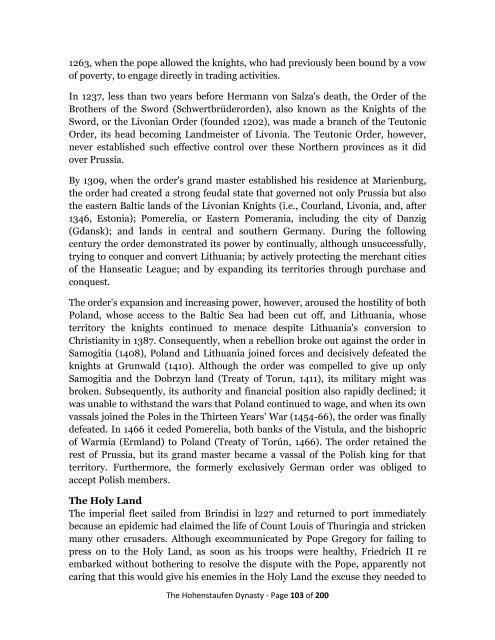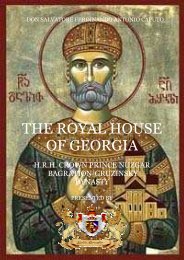here - Nobility Associations
here - Nobility Associations
here - Nobility Associations
Create successful ePaper yourself
Turn your PDF publications into a flip-book with our unique Google optimized e-Paper software.
1263, when the pope allowed the knights, who had previously been bound by a vow<br />
of poverty, to engage directly in trading activities.<br />
In 1237, less than two years before Hermann von Salza's death, the Order of the<br />
Brothers of the Sword (Schwertbrüderorden), also known as the Knights of the<br />
Sword, or the Livonian Order (founded 1202), was made a branch of the Teutonic<br />
Order, its head becoming Landmeister of Livonia. The Teutonic Order, however,<br />
never established such effective control over these Northern provinces as it did<br />
over Prussia.<br />
By 1309, when the order's grand master established his residence at Marienburg,<br />
the order had created a strong feudal state that governed not only Prussia but also<br />
the eastern Baltic lands of the Livonian Knights (i.e., Courland, Livonia, and, after<br />
1346, Estonia); Pomerelia, or Eastern Pomerania, including the city of Danzig<br />
(Gdansk); and lands in central and southern Germany. During the following<br />
century the order demonstrated its power by continually, although unsuccessfully,<br />
trying to conquer and convert Lithuania; by actively protecting the merchant cities<br />
of the Hanseatic League; and by expanding its territories through purchase and<br />
conquest.<br />
The order's expansion and increasing power, however, aroused the hostility of both<br />
Poland, whose access to the Baltic Sea had been cut off, and Lithuania, whose<br />
territory the knights continued to menace despite Lithuania's conversion to<br />
Christianity in 1387. Consequently, when a rebellion broke out against the order in<br />
Samogitia (1408), Poland and Lithuania joined forces and decisively defeated the<br />
knights at Grunwald (1410). Although the order was compelled to give up only<br />
Samogitia and the Dobrzyn land (Treaty of Torun, 1411), its military might was<br />
broken. Subsequently, its authority and financial position also rapidly declined; it<br />
was unable to withstand the wars that Poland continued to wage, and when its own<br />
vassals joined the Poles in the Thirteen Years' War (1454-66), the order was finally<br />
defeated. In 1466 it ceded Pomerelia, both banks of the Vistula, and the bishopric<br />
of Warmia (Ermland) to Poland (Treaty of Torún, 1466). The order retained the<br />
rest of Prussia, but its grand master became a vassal of the Polish king for that<br />
territory. Furthermore, the formerly exclusively German order was obliged to<br />
accept Polish members.<br />
The Holy Land<br />
The imperial fleet sailed from Brindisi in l227 and returned to port immediately<br />
because an epidemic had claimed the life of Count Louis of Thuringia and stricken<br />
many other crusaders. Although excommunicated by Pope Gregory for failing to<br />
press on to the Holy Land, as soon as his troops were healthy, Friedrich II re<br />
embarked without bothering to resolve the dispute with the Pope, apparently not<br />
caring that this would give his enemies in the Holy Land the excuse they needed to<br />
The Hohenstaufen Dynasty - Page 103 of 200



